Dean G. Duffy, "Transform Methods for Solving Partial Differential Equations, (2nd Edition)"
English | 2004-06-04 | ISBN: 1584884517 | 713 pages | DJVU | 6.1 mb
English | 2004-06-04 | ISBN: 1584884517 | 713 pages | DJVU | 6.1 mb
Transform methods provide a bridge between the commonly used method of separation of variables and numerical techniques for solving linear partial differential equations. While in some ways similar to separation of variables, transform methods can be effective for a wider class of problems. Even when the inverse of the transform cannot be found analytically, numeric and asymptotic techniques now exist for their inversion, and because the problem retains some of its analytic aspect, one can gain greater physical insight than typically obtained from a purely numerical approach.
Transform Methods for Solving Partial Differential Equations, Second Edition illustrates the use of Laplace, Fourier, and Hankel transforms to solve partial differential equations encountered in science and engineering. The author has expanded the second edition to provide a broader perspective on the applicability and use of transform methods and incorporated a number of significant refinements:
New in the Second Edition:
- Expanded scope that includes numerical methods and asymptotic techniques for inverting particularly complicated transforms
- Discussions throughout the book that compare and contrast transform methods with separation of variables, asymptotic methods, and numerical techniques
- Many added examples and exercises taken from a wide variety of scientific and engineering sources
- Nearly 300 illustrations–many added to the problem sections to help readers visualize the physical problems
- A revised format that makes the book easier to use as a reference: problems are classified according to type of region, type of coordinate system, and type of partial differential equation
- Updated references, now arranged by subject instead of listed all together
As reflected by the book's organization, content, and many examples, the author's focus remains firmly on applications. While the subject matter is classical, this book gives it a fresh, modern treatment that is exceptionally practical, eminently readable, and especially valuable to anyone solving problems in engineering and the applied sciences.
Welcome to my AH blog or Connect on my RSS
Hurry to download today, because tomorrow file may not be available!!!
Download File:
Hurry to download today, because tomorrow file may not be available!!!
Download File:



